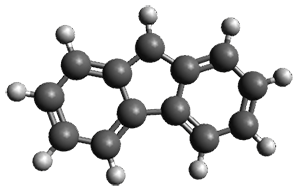Is the fluorenyl cation 1 antiaromatic or non-aromatic? This is still an open question. But the recent paper by Costa, et al. provides a new path towards potentially answering this question; they have finally synthesized this molecule.1
By photolizing 2 in low-density amorphous ice (LDA ice) and in deuterated ice at 8 K, they have identified a new IR spectrum.

To identify the origin of these spectra, they optimized the geometry of the fluorenyl cation 1 at B3LYP-D3/def2-TZVP (see Figure 1) and computed its IR spectra. These computed IR frequencies were then scaled by 0.97. The agreement between the computed and experimental frequencies is quite reasonable, and the isotopic shifts are also reasonably well reproduced. The agreement is not perfect, as seen in Table 1. Hopefully, further experiments will now be carried out to try to answer the lead question of this post.
Figure 1. B3LYP-D3/def2-TZVP optimized geometry of 1.
Table 1. Experimental and computed IR frequencies (cm-1)
and isotopic shift (in parentheses) of 1.
|
Calc. |
Exp. |
|
1008.8 |
986 |
|
1106.8 (+2.1) |
1076.8 (+1.7) |
|
1152.8 |
1117.2 |
|
1198.6 |
1163.5 |
|
1267.0 |
1235.1 |
|
1373.4 (-16.4) |
1343.7 |
|
1510.8(-8.3) |
1469.0 (-7.3) |
|
1530.7 (-3.2) |
1490.5 (-1.0) |
|
1616.8(-6.4) |
1575.7(-4.4) |
|
1640.9 (0.0) |
1601.2 (-4.0) |
References
(1) Costa, P.; Trosien, I.; Fernandez-Oliva, M.; Sanchez-Garcia, E.; Sander, W. "The Fluorenyl Cation," Angew. Chem. Int. Ed. 2015, 54, 2656-2660, DOI: 10.1002/anie.201411234.
InChIs
1: InChI=1S/C13H9/c1-3-7-12-10(5-1)9-11-6-2-4-8-13(11)12/h1-9H/q+1
InChIKey=KZCNYQVQQBONEY-UHFFFAOYSA-N


Henry Rzepa responded on 21 Apr 2015 at 2:50 am #
Steve,
I was interested in the two C-C(+) bond lengths and also the aryl-aryl C-C length. To get Jmol working is increasingly arduous on your site (one has to add a security exception to each computer’s Java configuration, then for my browser at least, flush the cache, and restart the browser for the exception to become recognised). Loading the coordinates into Jmol, then double-clicking each of the two atoms reveals the former length is 1.41Å and the latter 1.48Å. The latter value indicates no cyclic conjugation, but the C(+) is very strongly conjugated with the two benzo groups.
I also went to the supporting information for the article you cite to get more accurate coordinates (I presume you also did that when you wrote the post); http://onlinelibrary.wiley.com/store/10.1002/anie.201411234/asset/supinfo/anie_201411234_sm_miscellaneous_information.pdf?v=1&s=8626e7a3a730bf0c5502842cb6784d667e56663b and scrolled down to Table S7 (opening the PDF in Acrobat Reader, not the browser where it normally opens). I selected the coordinates and then pasted them into a text editor. I got a file with 84 lines. This comes from 21 atoms each with four fields = 84! In other words, for my system, it had put each element symbol and each individual cartesian coordinate on a separate line. Were I to try to recreate a sensible chemical file format (XYZ) I would have to join up the fields to recreate a file with 21 lines. A lot of work.
Clearly, only someone reasonably motivated (e.g. to write a blog or to comment upon it) will go through the above. And I dare say what actually happens very much depends on the operating system one uses (I used OS X, Safari, Acrobat Reader and BBedit for the above). It surely should not be like this. You and I have been making this point for perhaps 21 years now, with little impact!
Of course, a one-off for a blog is one thing; replicating this on a large scale (data mining) requires a much more elaborate system, not least because every PDF and every publisher seems to do things slightly different. So the holy grail of automating this cannot be achieved by such mechanisms!
We should strive to implement what is called FAIR data ASAP (FAIR = findable, accessible, interoperable, reusable) rather than continue to suffer the mess exemplified by the above! But as long as publishers control and define the rules, this seems very unlikely to happen. And recollect that authors are increasingly paying between $1250 – $5000 as “article processing charges”. Clearly these charges do not include the task of creating FAIR data. Quite possibly if they did, the publishers would automatically double the APCs. But one cannot help but wonder what e.g. $1250 actually brings; you think it should bring FAIR data at very least!